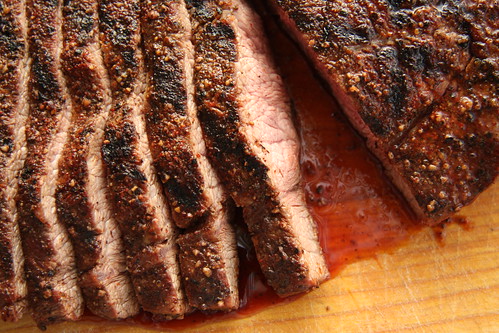Flat Iron Steak...how do I love thee?
Regular readers (or even the occasional reader who just looks at the pictures) will realize that I have a love affair with grilled red meat. I am unsure as to the lusty origin of this relationship, but it goes back far. It probably has something to do with the fact that my Mom grew up on a farm and my Grandfather was in the meat business. Whatever the reason, I have found my new weekday fix: Flat Iron Steak.
I first tried a flat iron last summer, when I was looking for meat for fajitas. I grilled it hot and fast, sans marinade. It turned out incredible. I have since grilled it a number of times. I have never been disappointed with the results. Although I have always cut the steak on the perpendicular, I began to wonder if the flat iron would stand up on it own, and it did. So for the record, I have a great tasting tender steak. What could make it even better? Try cheap. It comes vacuumed sealed, so I can pick one up at Kroger, threw it in the back of the fridge, and have a few weeks to let it sit until I pull it out on a whim.
I went looking for some information about the cut, and was surprised to learn that a flat iron steak was the product of the beef industry looking for untapped beef cuts. A November 2007 article from the University of Florida News describes the flat iron evolution.
I hope I have encouraged you to pick one up. If so...
I first tried a flat iron last summer, when I was looking for meat for fajitas. I grilled it hot and fast, sans marinade. It turned out incredible. I have since grilled it a number of times. I have never been disappointed with the results. Although I have always cut the steak on the perpendicular, I began to wonder if the flat iron would stand up on it own, and it did. So for the record, I have a great tasting tender steak. What could make it even better? Try cheap. It comes vacuumed sealed, so I can pick one up at Kroger, threw it in the back of the fridge, and have a few weeks to let it sit until I pull it out on a whim.
I went looking for some information about the cut, and was surprised to learn that a flat iron steak was the product of the beef industry looking for untapped beef cuts. A November 2007 article from the University of Florida News describes the flat iron evolution.
(Dwain) Johnson, who developed the steak in cooperation with the University of Nebraska and the cattlemen’s association, said their research was aimed at identifying undervalued portions of the beef carcass. In the largest study of its kind, the researchers evaluated more than 5,600 muscles for flavor and tenderness.5,600 different muscles? That must have been one hell of a tasting! A 2002 article from the University of Nebraska talks about the butchering process.
The flat iron comes from the top shoulder of the chuck. This muscle's looks can deceive even a trained meat-cutter's eye. A seam of connective tissue runs down the middle of it, making it appear tough.Some have equated the taste of flat iron to strip steaks, and I can see the comparison. Although, my favorite will always be a bone-in ribeye. The creation of flat iron steak is basically the result of a business decision. Maximizing the value of the cow.
"It's easy to look at this and perceive that this meat isn't tender, but you'd be wrong," he said. "If you remove the connective tissue, the rest of the muscle is exceptionally tender – one of the three most tender cuts."
Removing the connective tissue involves literally going against the grain – cutting the muscle lengthwise, contrary to meat cutters' training.
"It's like filleting a catfish," Calkins explained. After removing the connective tissue, the muscle looks like two fish fillets.
I hope I have encouraged you to pick one up. If so...
1. Preheat your grill to high.Enjoy!
2. Allow your steak to sit at room temperature for approximately 20 minutes before grilling.
3. Season both sides well with freshly cracked pepper and salt
4. Oil your grill's grates.
5. Place the steak on the grill. After 3 minutes rotate the steak 90 degrees. After another 3 minutes flip the steak over.
6. After 3 minutes, rotate the steak 90 degrees. The steak should be about medium rare after an additional 3 to 5 minutes.
6. Allow to rest for approximately 5 minutes, cut and serve.
7. The times I used are based on my grill (hot is 650-700 degrees), your times may be a little different. The key is not to overcook.


